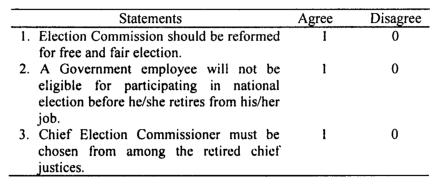In its most basic form, attitude scaling requires that an individual agrees or disagrees with a statement or responds to a single question. For example, respondents on a political issue may be asked whether they agree or disagree with the following statements:
Each respondent selects either a positive response (agree) or a negative response (disagree) which most accurately describes his/her attitude towards the opinion.
A person’s score is computed by summing up the number of questions he or she answers.
In the present context, where the responses have been coded 1 and 0, a person who agrees with all the opinions makes a maximum score (3 here) on the scale, and a person who disagrees with all opinions receives a score of 0.
Because this type of self-rating scale merely classifies respondents into one of two categories, it has only the properties of a nominal scale.
Single Response Scale
A Simple Category Scale is a basic form of attitude scaling that requires an individual to either agree or disagree with a statement or respond to a single question. It classifies respondents into specific categories based on their responses.

Many people believe that attitudes vary along a continuum. Thus, an attitude scale aims to find an individual’s position on a continuum of multiple choices.
When there are multiple options for the rater, and only one response is sought, this scale can be employed. These options provide the respondents with more flexibility in the rating operation.
We can ensure more information if the categories are ordered according to a descriptive or evaluative dimension.
An example of this scale is as follows:
| How frequently the Family Welfare Assistant visits you?The responses to these questions are provided below:
|
Each respondent selects one response category that most accurately describes his or her opinion about the statement reflecting the concept (frequency of visits) being measured.
The data obtained by this rating scale is ordinal in nature.
The above category scale is more sensitive and more informative than a scale with only two response categories. It is, however, to be noted that wording is an important factor in the usefulness of these scales.
Multiple Response Scale
This scale allows the rater to select one or several alternatives from the multiple options. Here is an example:
Check one or more of the following sources you consulted while designing your new apartment complex:
|
Here too, a respondent’s total score is the summation of the scores he or obtains in an interview expressing his/her opinion.
Conclusion
How is a person’s score computed using the Simple Category Scale?
A person’s score is determined by summing up the number of questions he or she answers. In contexts where responses are coded as 1 and 0, a person agreeing with all opinions achieves the maximum score on the scale, while disagreeing with all opinions results in a score of 0.
What is the difference between a Single Response Scale and a Multiple Response Scale?
A Single Response Scale offers multiple options for the rater, but only one response is sought. In contrast, a Multiple Response Scale allows the rater to select one or several alternatives from the provided options.
What type of data is obtained from the Single Response Scale?
The data acquired from the Single Response Scale is ordinal in nature.
Why is wording considered important in the usefulness of category scales?
Wording plays a crucial role in the effectiveness of category scales because it influences the clarity and interpretation of the scale, ensuring that respondents understand and respond accurately.
Can you provide an example of a Single Response Scale?
An example is: “How frequently does the Family Welfare Assistant visit you?” with response options like “Never,” “Rarely,” “Sometimes,” “Often,” and “Very often.”
How does the Simple Category Scale differ from other scales?
The Simple Category Scale primarily classifies respondents into specific categories based on their agreement or disagreement with statements. It is more straightforward than scales that measure intensity or frequency and typically offers fewer response options.

